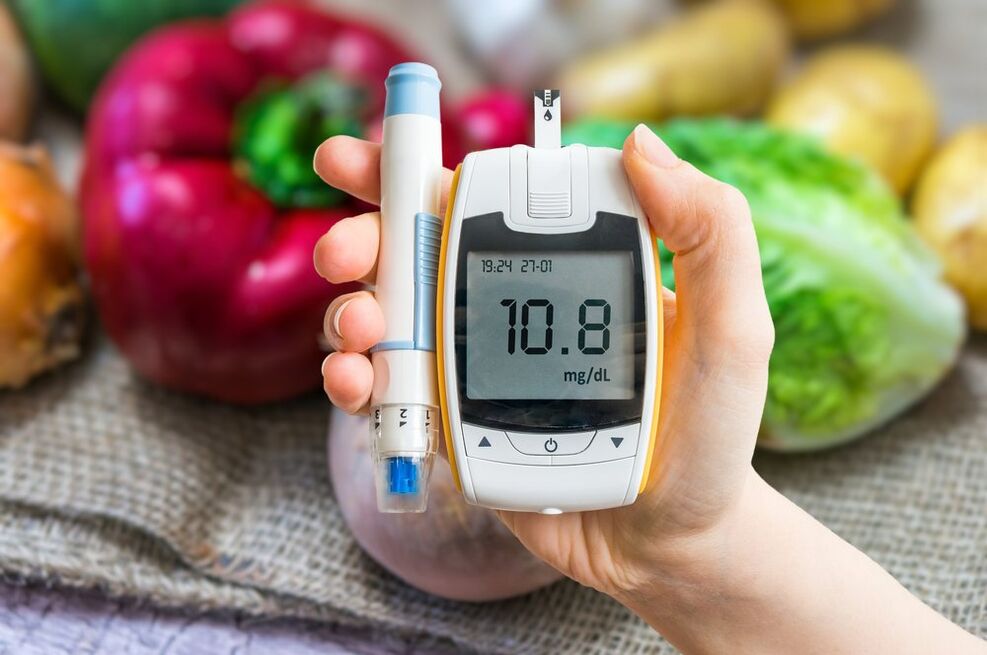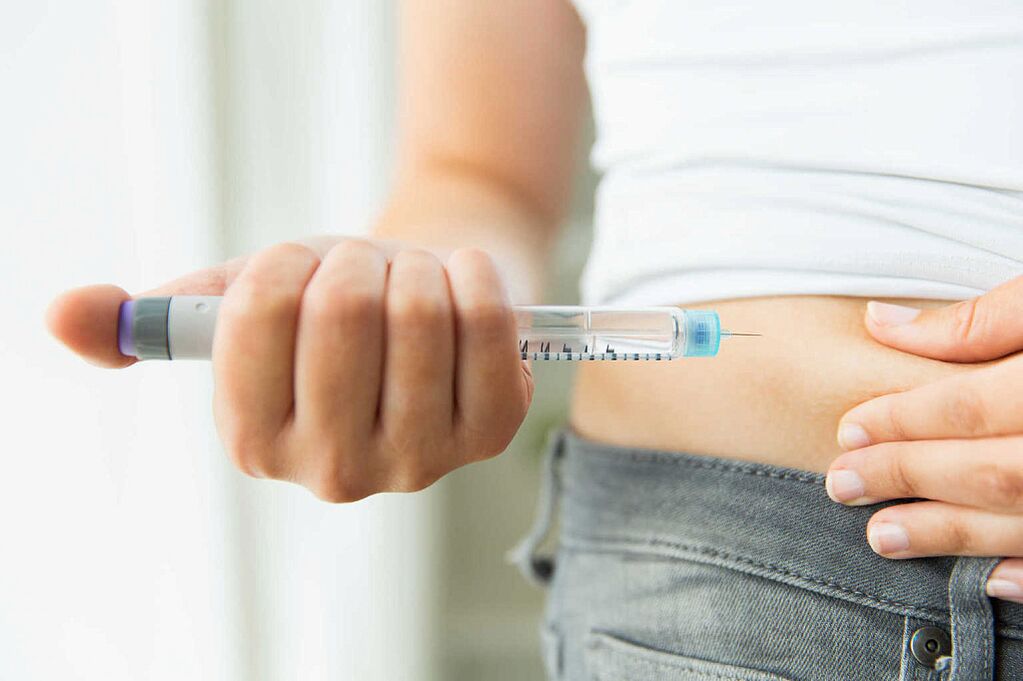
Diabetes mellitus(DM) is an endocrine pathology that occurs due to insufficient synthesis/action of insulin.Against this background, chronic hyperglycemia develops - a condition accompanied by a constantly elevated level of sugar (glucose) in the blood plasma.Hyperglycemia is the main cause of the symptoms and complications of diabetes: metabolic disturbances, damage to blood vessels and nerve fibers, kidney failure and blindness.
In the last forty years, the number of people with diabetes has almost quadrupled worldwide.The disease spreads fastest in underdeveloped countries and countries with weak economies.Doctors observe that the incidence increases in the over-40 age group.In terms of its social importance, this pathology ranks third after cardiovascular diseases and cancer.
Diabetes mellitus can be divided into two main types:
- insulin-dependent (adolescents, young people, children),
- insulin independent (insulin resistant).
They have different causes, different symptoms, treatment tactics and prognosis.Therefore, we will consider them separately in the future.
Reasons

Insulin is a protein hormone that is synthesized in the beta cells of the pancreas.Its effect is exerted through insulin receptors in various organs and tissues.Diabetes occurs when beta cells die or when receptors become less sensitive.
Type 1 diabetes it develops in the presence of a genetic predisposition.The impetus for the development of pathology is given by toxins and viral infections, for example, rubella, influenza, hepatitis B virus, cytomegalovirus and retroviruses.The provoking factor causes acute damage to the β-cells or leads to the persistence of the infectious agent in the tissues of the pancreas, with the further development of an autoimmune reaction.The probability of the disease increases if a person has other autoimmune diseases - thyroiditis, adrenal insufficiency, etc.
Important!Diet plays a certain role in the occurrence of the disease in children.So this is facilitated by too early contact with gluten - it is optimal to introduce cereal porridge into complementary foods within 6-7 months at the earliest.The risk increases when feeding a child with cow's milk, vitamin D deficiency and high nitrate concentrations in drinking water.
Thanks to our body's adaptability, type 1 diabetes can remain silent for many years.The first signs appear when the number of β-cells (and, accordingly, insulin) is insufficient to regulate glucose levels.Type 1 accounts for approximately 10% of pathological cases.It mainly affects children, adolescents and people under 30 years of age.Less often in older patients, it occurs in a latent form, which is often confused with non-insulin dependence.
Type 2 diabetes it is accompanied by impairment of insulin secretion and reduced sensitivity of insulin receptors, otherwise "insulin resistance".The most important risk factors:
- Hereditary tendency can be observed in almost all cases.If close relatives have the disease, the risk of developing the pathology increases sixfold.
- Obesity often has an abdominal and visceral form, when excess fat is deposited mainly on the waist and/or internal organs.With class I obesity, the risk of developing the disease is 2 times higher, with class II obesity.class 5 times, the III.class increases 10 times.
Important!High-calorie foods dominated by simple, quickly digestible carbohydrates are considered diabetogenic.These are sweets, alcohol, flour products, sausage, fast food, fried potatoes, soft wheat pasta.Combined with a sedentary lifestyle and a lack of plant fiber, regular consumption of such foods can cause irreparable damage to the body.
The second type usually occurs in adulthood.A trend can be observed: the older a person is, the higher the concentration of glucose in the blood after a meal containing carbohydrates.The rate at which glucose decreases to normal is highly dependent on muscle mass and degree of obesity.As childhood obesity is now an epidemic, type 2 is becoming more common in children.
As in the previous case, the disease develops when the amount of synthesized insulin cannot fully compensate for the decrease in the sensitivity of insulin receptors.This creates a vicious cycle: the excess glucose in the blood has a toxic effect on the beta cells, causing them to malfunction.
Diabetes: symptoms of an insidious disease
Consider the clinic of diabetes depending on the disorders it causes, the stage of the disease and the type of pathology.
Symptoms related to metabolic disorders
Insulin is involved in all types of metabolism:
- Carbohydrate - regulates plasma glucose levels, as well as glycogen breakdown, gluconeogenesis, and other reactions involving sugars.
- Fatty - increases the synthesis of fatty acids and reduces their entry into the blood.
- Protein - enhances protein synthesis and suppresses its degradation, activates DNA and RNA replication.
- Electrolyte - activates the flow of potassium and inhibits the flow of sodium into the cells.
With all these physiological effects, the change in insulin concentration does not pass without leaving a trace in the body.The main symptoms are related to the disorder of carbohydrate metabolism, especially hyperglycemia.Elevated glucose levels lead to the following symptoms:
- thirst, dehydration, polyuria - more than three liters of urine per day;
- polyphagia - constant need for food, gluttony, develops in response to lack of energy;
- nausea, vomiting;
- accumulation of sorbitol (a product of glucose conversion) in nerve fibers, retina, lens, with subsequent damage;
- susceptibility to bacterial and fungal infections.
Due to the disorder of protein metabolism, the following symptoms of diabetes mellitus develop::
- muscular dystrophy - appears due to reduced synthesis and increased breakdown of protein;
- hypoxia - lack of oxygen in the tissues - causes lethargy, reduced concentration and drowsiness;
- generalized vascular damage due to protein glycosylation.
The disorder of fat metabolism manifests itself in it:
- increasing the concentration of cholesterol in the blood;
- fatty liver infiltration;
- ketonuria, ketonemia - accumulation of ketones in the blood and urine;in high concentrations, coma and death develop without treatment.
Loss of electrolytes (potassium, magnesium, sodium, phosphorus) causes general and muscle weakness..
Clinic depending on the stage of the disease
The initial stage is characterized by an almost complete absence of symptoms.Diagnosis sometimes takes years, especially without proper testing.In the case of diabetes, the symptoms come and go according to fluctuations in blood sugar levels.General manifestations predominate, as the damage to the internal organs is still far away.
Patients complain of:
- severe weakness, fatigue;
- thirst - patients can drink about 3-5 liters of liquid per day, and a significant amount at night;
- typical dry mouth (due to dehydration);
- frequent and copious urination;children may develop enuresis;
- skin itching, especially in the genital area in women.
Important!Progressive tooth decay and periodontal disease are often among the first symptoms of diabetes.Loose teeth and deep carious lesions in the roots of the teeth indicate a pre-diabetic condition.Biochemical analysis of blood glucose concentration shows no visible changes.Therefore, if such symptoms are detected, the patient is recommended to visit a therapist and take a glucose tolerance test.
Without treatment, the patient's condition gradually worsens.Dry skin appears, skin infections are common - hidradenitis, furunculosis, fungal infections of the feet.From the gastrointestinal tract, gastrointestinal dysfunction, gallbladder dyskinesia, chronic gastritis and duodenitis can be observed.Arteriosclerosis and coronary heart disease develop as a result of damage to the vascular system and increased cholesterol levels.The latter is usually difficult and often leads to serious complications.Heart attack is the cause of death for 38-50% of patients.
People with diabetes are more likely to develop bronchitis, pneumonia and are prone to tuberculosis.Men with prostate adenoma and women over 50 are 4 times more likely to suffer from cystitis and pyelonephritis than ordinary people.In an advanced stage, blindness and other complications may occur due to damage to the vascular system.
Signs of type 1 and type 2 diabetes
With the first type, people often do not notice or ignore the initial symptoms.A common situation is when the diagnosis is made only after the first "attack" of ketoacidosis.The disease manifests itself as a response to stress, viral infection and an overload of simple carbohydrates.Since sugars are extremely poorly absorbed, tissues and organs are deficient in energy.To compensate for the lack of energy, the body begins to actively burn fat.This process is accompanied by the release of ketone bodies.
Ketone bodies are toxic to humans in large quantities.The patient feels thirsty, dizzy, lethargic, sleepy, and has rapid heartbeat.Frequent urination, abdominal pain, nausea, vomiting and the smell of acetone from the mouth.Without proper treatment, ketoacidosis can lead to coma, brain swelling, and death.
Important!If you have already been diagnosed with diabetes, you can prevent ketoacidosis on your own.
To do this, you must:
- in case of acute respiratory tract infections, acute respiratory viral infections, the plasma sugar level must be checked more often and the appropriate amount of insulin given;
- when using other drugs, warn your doctor about the presence of diabetes (for example, glucocorticoids increase the need for insulin);
- do not stop taking the drug even during remission - just reduce the dose and consult a doctor to correct the therapy;
- do not miss injections and strictly monitor glucose levels;
- inject insulin with the right tools and in the right place;
- monitor the expiration date and storage conditions of the medicine.
The other three main symptoms of type 1 diabetes are fatigue, weight loss, and constant hunger.- arise due to the inability to use sugars as an energy source.And in order to get rid of excess glucose, the body actively removes it with urine, which provokes polyuria.As a result of dehydration, the patient feels severe weakness.
The second type is characterized by a slower flow.The patient notices the problem when hyperglycemia becomes chronic.Sometimes the disease is discovered accidentally during a routine examination.There are situations when the patient comes to the endocrinologist in an advanced stage of the disease with complications.The most common complaints of this type of pathology are drowsiness, weakness, lethargy, difficulty concentrating and nausea.
Classification and types
The World Health Organization offers a rather comprehensive classification of pathology.So, in addition to the already known first and second types, other specific types of the disease are also distinguished.All of the III.category, and according to the reason for their development, they can be classified into classes A, B, C, D, E, F, G and H.
- This class includes genetic defects in the functioning of beta cells - mitochondrial mutations, damage to certain sections of certain chromosomes.
- Also genetic errors, but not in the cells of the pancreas, but at the level of insulin receptors.These include Donohue syndrome, Rabson-Mendenhall syndrome, some lipodystrophies, and type A insulin resistance.
- Diseases of the exocrine pancreas (fibrosis, pancreatitis, neoplasia, trauma, etc.).
- Endocrinopathies.The disease can develop against the background of Cushing's syndrome, pheochromocytoma, thyrotoxicosis and other endocrine pathologies.
- Diabetes induced by chemicals and drugs - nicotinic acid, thyroid hormones, glucocorticoids, alpha-interferon, etc.
- Viral infections - cytomegalovirus, congenital rubella and others.
- Atypical forms of immune-mediated diabetes.
- Genetic defects, the clinical picture of which often includes symptoms of diabetes (myodystrophy, Turner syndrome, Down syndrome, porphyria).
Separately, IV.category is gestational diabetes, which is a hidden disorder of carbohydrate metabolism in pregnant women.
Important!The tactics of treating diabetes mellitus largely depend on its type.Therefore, it is recommended to see a doctor as soon as possible to determine the exact cause of the unpleasant symptoms.An experienced endocrinologist prescribes the necessary examination and finds the source of the disease.
Diagnosis and screening

The diagnosis is based on the following criteria.
- The patient's medical history, symptoms and complaints.
- Examination of the patient to identify possible complications.
- Biochemical blood test - determination of fasting plasma glucose concentration (FPG).It must be taken on an empty stomach, with the last meal no later than 8-12 hours before the examination.
- Determination of glycosylated hemoglobin (HbA1C) level.Rent the same.Avoid smoking, drinking alcohol and intense physical activity the day before.
- Glucose tolerance test (OGTT).More sensitive, but also more complex analysis.It is mainly used to diagnose prediabetic conditions, including during pregnancy.If the FPG is more than 7.0 mmol/l, the OGTT is not performed.
In reality, pathology is often detected by random analysis, for example, during regular screening.The patient is then sent for further examination.
Diagnostic criteria for diabetes and prediabetes
| Analysis | Norm, mmol/l | Impaired carbohydrate metabolism (prediabetes), mmol/l | DM, mmol/l |
|---|---|---|---|
| GPN | less than 5.6 | 5.6 to 6.9 | more than 7.0 |
| HbA1C | less than 5.7% | 5.7-6.4% | Greater than or equal to 6.5% |
| OGTT | less than 7.8 | 7.8 to 11.0 | more than 11.1 |
| It's random | less than 11.1 | - | with more than 11.1 symptoms |
Important!The recently popular urine sugar test is no longer used due to its non-specificity and low sensitivity.
Persons belonging to the high-risk group are recommended to have an FPG and HbA1C (or OGTT) test regularly, once every three years.If the FPG is already elevated, such a check should be done annually.Risk factors include:
- physical inactivity;
- obesity;
- age > 35 years;
- Diabetes in the family;
- personal history of prediabetes, gestational diabetes, PCOS, cardiovascular diseases;
- birth of a child weighing more than 4.1 kg;
- hypertension;
- fatty liver hepatosis;
- high cholesterol, "bad" lipids - low-density lipoproteins;
- HIV infection.
After diagnosis, all diabetics should be regularly checked for complications.Standard screening includes an eye exam, foot exam, urine test for proteinuria, lipid test, and creatinine level.Most endocrinologists consider it important to record a baseline ECG and lipid profile during the initial treatment in order to study the dynamics of the disease and predict the risk of cardiovascular diseases.If necessary, consultation with specialists is prescribed - ophthalmologist, gynecologist, cardiologist, neurologist.
The most dangerous complications

All complications arising from this disease can be divided into acute and chronic conditions.Acute symptoms usually occur when:
- skipping insulin injections or taking glucose-lowering medication;
- use of other drugs affecting carbohydrate metabolism;
- severe stress;
- alcohol abuse;
- self-discontinuation of therapy;
- in the background of severe trauma, surgery, infection;
- during pregnancy.
This includesketoacidotic statewhich is detailed above andhypoglycemic coma.Ketoacidosis and hypoglycemia often develop suddenly, and only a few hours can pass from the first symptoms to complete coma.Both complications should be stopped as quickly as possible, if necessary, by consulting a doctor.
Hypoglycemia- reduced blood sugar level - characterized by increased sweating, chills, strong weakness and a strong feeling of hunger.Some patients experience numbness and tingling in certain areas of the body.If the necessary measures are not taken, hypoglycemia turns into a coma - the patient loses consciousness.In this situation, you should call an ambulance.
Important!In order to eliminate hypoglycemia, a person urgently needs to consume simple carbohydrates.Lemonade, lump sugar (put under the tongue), fruit juice - anything that is easy to swallow and quickly absorbed is suitable.In order to avoid such cases, patients taking blood sugar-lowering drugs should always keep any of the above products with them.
Other complications are the consequences of metabolic disorders and damage to small and large blood vessels.
- Diabetic heart disease or "diabetic heart".Myocardial dystrophy develops in people over 40 years of age, without obvious signs of coronary atherosclerosis.It manifests as left ventricular dysfunction and leads to heart failure.The main symptoms are shortness of breath, arrhythmia and reduced tolerance to physical activity.
- Metabolic syndrome X or the "deadly four".The combination of hyperglycemia, obesity, high blood pressure and atherosclerosis causes early onset of angina pectoris and damage to peripheral arteries.Common complications are heart attack, stroke, and transient ischemic attacks.The main problem is that each element of the quartet amplifies the manifestations of others, creating a vicious circle.
- Diabetic nephropathy.It is a leading cause of disability and death among people with diabetes.It develops in 40-50% of cases and leads to chronic and end-stage renal failure.The main cause is damage to the kidney capillaries, increased pressure in the glomeruli of the kidney.The presence of high blood pressure accelerates pathological processes.This complication is considered one of the most insidious, as it does not give noticeable symptoms in the early stages.The patient usually does not associate swelling, dyspepsia, and weakness with kidney damage.Pain and urinary disorders appear in the later stages, when the problem is already difficult to treat.
- Diabetic retinopathy.Subjectively, it is as if there is a fog in front of the eyes, a characteristic "blinking of flies".Surrounding objects become blurry and blurred.Reduced vision extends to complete blindness.The cause is damage to the retinal vessels, which is then accompanied by the appearance of microaneurysms, hemorrhages, and edema.To prevent vision loss, patients should have an eye exam once a year and receive treatment if problems arise.
- Neuropathies.Due to the toxic effect of glucose, the lack of oxygen and the shift of the electrolyte, the functioning of the neurons is disturbed.Diabetic patients experience a large number of neuropathies, but the most common of these is symmetric polyneuropathy.Its main symptoms are numbness, discomfort, pain, loss of sensation in the hands and feet, "like in gloves and socks."Such processes can lead to inappropriate loads in the lower limbs, further trauma or infection of the foot and degeneration of the joints.Neuropathies affect not only the peripheral nerve fibers, but also the cranial nerves and the brain tissue itself.This results in acute neuropsychic disorders, neurosis-like states, dysfunction of innervated areas - loss of hearing, vision, smell, etc.
- Diabetic foot.Against the background of damage to blood vessels, nerves, skin and joints, a syndrome occurs, which is accompanied by ulceration of the soft tissues and purulent-necrotic processes.Necrosis of the foot ends with amputation of the affected area.The syndrome occurs in 20-25% of patients.
Treatment: diet and drugs

Treatment of diabetesit starts with a lifestyle change.This includes a properly structured diet, sufficient physical activity and regular monitoring of plasma glucose levels.All this, combined with the basic therapy, helps to prevent the rapid progression of the pathology and the development of complications.
Type 1 diabetes is also treated with insulin.Regular subcutaneous injections mimic the function of beta cells.The number of units and the scheme are selected individually.It is important to observe the timing and dosage of the drug.
Type 2 patients, in the event that diet and physical activity are not sufficient,antihyperglycemic drugs are prescribed.These drugs differ in their mechanism of action:
- stimulates the secretion of own insulin (sulfonylureas, meglitinides);
- increases the sensitivity of insulin receptors (thiazolidinediones);
- inhibit further pathways of glucose production (biguanides);
- they prevent the absorption of sugars in the intestinal wall, slowing down their digestion (alpha-glucosidase inhibitors);
- increase the excretion of glucose in the urine (NGLT-2 inhibitors).
These drugs work together, enhancing each other's effects.Both therapeutic and prophylactic agents are widely used.Statins and acetylsalicylic acid help reduce damage from damage to the vascular system, and ACE inhibitors help in the early stages of nephropathy.
The forecast is up to you

About four million people die each year from this insidious disease.In children and adolescents, the main cause of death is ketoacidosis, which progresses to coma.In adults, the presence of complications and alcohol consumption are critical.The average life expectancy of people with diabetes is reduced by 6-15 years.In the second type, prognosis is highly correlated with lifestyle.Smokers, alcoholics, and people with high cholesterol can extend their lives by simply giving up bad habits and changing their diet.
The disease ranks first among the factors that cause blindness, it doubles the risk of stroke and heart attack, it increases the risk of chronic kidney failure by 17 times, and the risk of foot death by 20 times.Despite the terrible numbersthe prognosis depends on the timeliness of the diagnosis and your personal attitude to the disease.The earlier the disease is detected and the more carefully the patient approaches the treatment, the higher the survival rate.
Prevention

Preventive measures consist of:
- Regular and appropriate physical activity.The latter normalizes metabolism and increases the sensitivity of tissue receptors to insulin molecules.
- Diet.Meals are fractional, 4-5 times a day, in small portions.The consumption of simple carbohydrates and saturated fats should be minimized.Avoid mayonnaise, pastries, jams, sausages and starchy foods.Avoid fried, fatty, overly salty foods, junk food, smoked foods, and canned foods.The basis should be complex carbohydrates, fiber and pectin.We prefer lean fish, poultry, vegetables, herbal infusions, unsweetened compotes, pasta made from durum wheat.Follow the 20:20:60 BJU ratio.
- Prevention of infections.The first type of diabetes mellitus often manifests as a result of a viral infection.Therefore, if there are risk factors, it is recommended to strengthen the immune system, prevent the prolonged course of ARVI, wear a mask and use antiseptics during epidemics and near sick people.
























